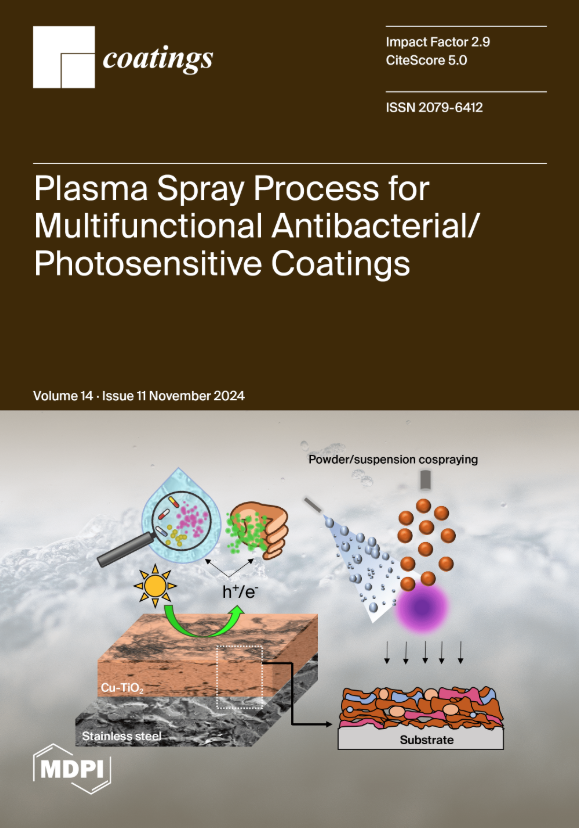Study of a New Novel HVOAF Coating Based on a New Multicomponent Al80Mg10Si5Cu5 Alloy
IF 2.8
3区 材料科学
Q2 MATERIALS SCIENCE, COATINGS & FILMS
引用次数: 0
Abstract
This paper presents and demonstrates the development of a new lightweight coating for aluminum alloy from a novel multicomponent alloy based on the AlSiMgCu system. The coating was applied using a newly designed approach that combined high velocity oxy-fuel (HVOF) and plasma spraying processes. This hybrid technique enables the deposition of coatings with enhanced performance characteristics. The optical microscopy (OM) and scanning electron microscopy with energy dispersive X-ray spectroscopy (SEM + EDS) revealed a strong adhesion and compaction between the multicomponent coating and the A6061 substrate. The new coating improved hardness by 50% and increased electrical conductivity by approximately 3.3 times compared to the as-cast alloy. Corrosion tests showed a lower corrosion rate, comparable to thermally treated A6061 alloy. Tribological tests indicated over 20% reduction in friction and over 50% reduction in wear rate. This suggests that multicomponent aluminum coatings could improve automotive and parts in contact with hydrogen by enhancing hydrogen fragilization resistance, corrosion resistance, electrical conductivity, and wear properties, with further optimization of thermal spraying potentially boosting performance even further.基于新型多组分 Al80Mg10Si5Cu5 合金的新型 HVOAF 涂层研究
本文介绍并展示了一种新型铝合金轻质涂层的开发过程,该涂层由一种基于 AlSiMgCu 系统的新型多组分合金制成。该涂层采用了一种新设计的方法,结合了高速富氧燃料(HVOF)和等离子喷涂工艺。这种混合技术能沉积出性能更强的涂层。光学显微镜(OM)和扫描电子显微镜与能量色散 X 射线光谱(SEM + EDS)显示,多组分涂层与 A6061 底材之间具有很强的附着力和压实性。与铸造合金相比,新涂层的硬度提高了 50%,导电率提高了约 3.3 倍。腐蚀测试表明,腐蚀率较低,与经过热处理的 A6061 合金相当。摩擦学测试表明,摩擦力降低了 20% 以上,磨损率降低了 50% 以上。这表明,多组分铝涂层可以通过增强抗氢脆化、耐腐蚀、导电性和磨损性能来改善汽车和与氢接触部件的性能,而热喷涂的进一步优化则有可能进一步提高性能。
本文章由计算机程序翻译,如有差异,请以英文原文为准。
求助全文
约1分钟内获得全文
求助全文
来源期刊

Coatings
Materials Science-Surfaces, Coatings and Films
CiteScore
5.00
自引率
11.80%
发文量
1657
审稿时长
1.4 months
期刊介绍:
Coatings is an international, peer-reviewed open access journal of coatings and surface engineering. It publishes reviews, research articles, communications and technical notes. Our aim is to encourage scientists to publish their experimental and theoretical results in as much detail as possible. There is no restriction on the length of the papers. Full experimental and/or methodical details must be provided. There are, in addition, unique features of this journal:
* manuscripts regarding research proposals and research ideas will be particularly welcomed
* electronic files or software regarding the full details of the calculation and experimental procedure - if unable to be published in a normal way - can be deposited as supplementary material
 求助内容:
求助内容: 应助结果提醒方式:
应助结果提醒方式:


